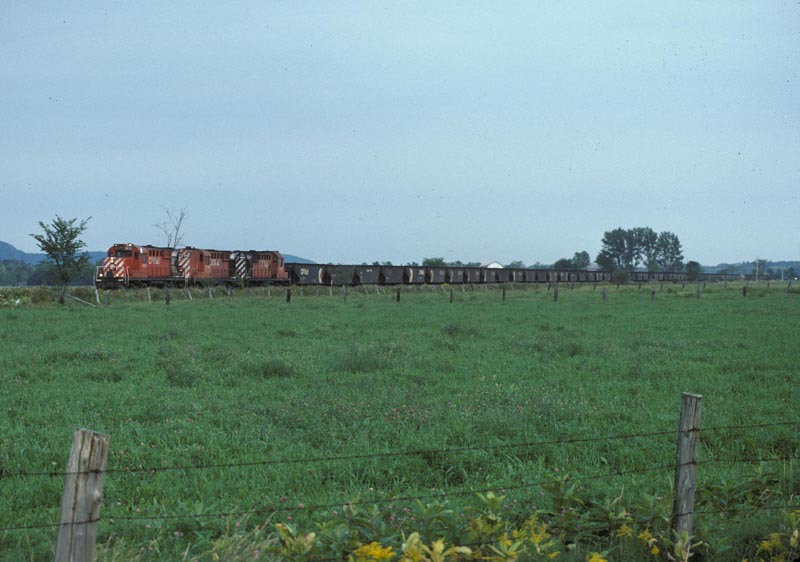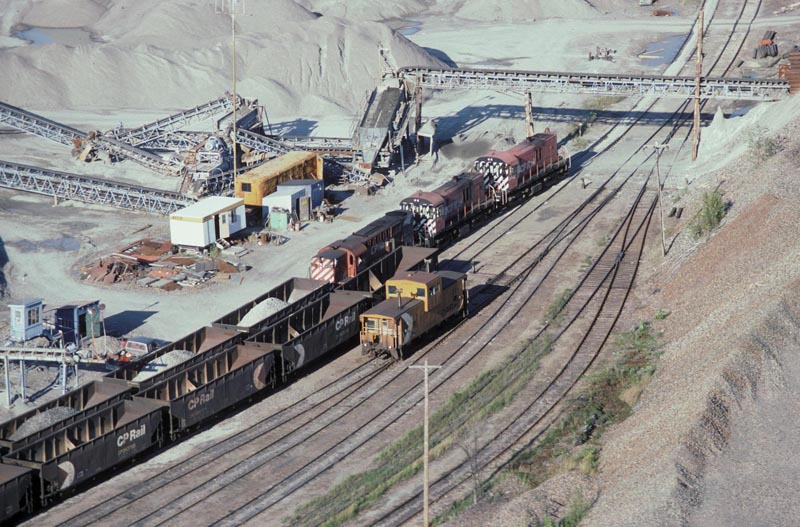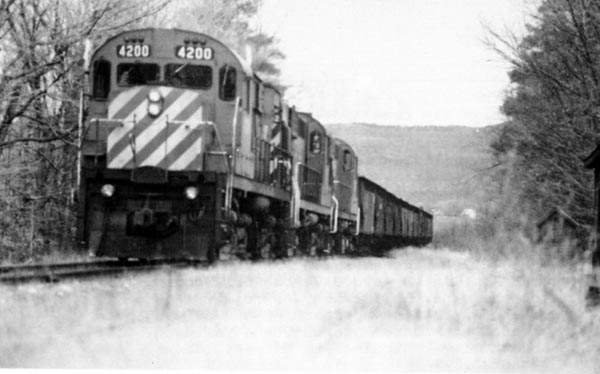
 It's almost Noon as I arrive at Walkley Yard. If everything turns out as planned, I will be spending the remainder of the day aboard a rock train (the Hilton Mine Turn) on CP Rail's Waltham Subdivision. Action on my scanner indicates that No. 85, the connecting freight train from Montreal, is in the area. As I enter the yard office, I greet the Terminal Supervisor and fill out the necessary clearance forms. "Has No. 85 arrived at Gatineau?" "No, not yet. They hit a cow three miles east of there and have been delayed." I am not surprised. Cattle and trains have enjoyed a close relationship over the years. Too bad cows can't read timetables. Sure hope this isn't a sign of things to come. The crew for the mine job is from Smiths Falls and arrive shortly after I do. Their questions directed at the Supervisor are much like mine and his responses bring only a few grumbles. I guess this is nothing new for them. Much to my delight, I recognize the engineman and the conductor. The head end brakeman is relatively new to the road and will be making his first trip "up the line", as they say in the "Pontiac". After an exchange of pleasantries with the Conductor, including his approval to ride with him in the van, I do my best to stay out of everyone's way. The last thing I want to do is to make a nuisance of myself. Outside of the yard office and next to the diesel shop sits RS-18u No. 1820, patiently awaiting sister engines 1807 and 8796 (RS-18) off Train 85. The three units will be used for the Mine Turn which today, with 51 hoppers, 2 box cars, and the van, is the biggest of the year. I learn that the box cars are carrying supplies for the section gang and have been billed to the mine. It's almost 14:00 when No. 85 finally backs into the yard. An agitated conductor steps down and is greeted by the Supervisor. In broken English, he takes out his frustration on the official who handles the situation quite calmly and says very little. The Skipper's condition doesn't improve a great deal when he's informed that return train No. 86 can't leave for Montreal until the mine train returns from Hilton which in all likelihood won't be until well past midnight. The idea of a long layover in Ottawa, especially on a weekend, doesn't sit well and he stomps off to talk to the Montreal dispatcher, muttering something about booking off and taking the bus home. I approach the Supervisor and I'm told that the gentleman in question, "tends to get a little worked up." Ah, the joys of railroading. Needless to say, the cow has had nearly as much impact on the front of Locomotive 1807 as the conductor's impatience. After a crew change, the three units are mu'ed and our train ia assembled. Two of the hoppers brought in from Montreal have doors jammed open. Unsuitable for loading, they are cut out. With things progressing quickly now, I return to the yard office to pick up my gear and check to make sure that I have my signed release form in case any unexpected railway officials happen along. As I enter the yard office, the telephone rings. It's Hilton Mines wondering if a train will be coming up. With a few calming sentences, the Supervisor assures the other end that things are starting to roll. By 14:30, we're just about ready to leave. The conductor walks the train, making his Number 1 brake test, while I board van No. 434529, my home for the next ten hours. Suddenly we lurch ahead. After a few car lengths, however, we come to an abrupt stop. I peer out around a corner of the van and see the conductor standing nearby. I'm told that another car has to be set out before we leave. Finally, at 15:00, our train is rolling under the Bank Street bridge. I stow my belongings and prepare to climb up into the cupola, taking the time to ask the conductor which side he prefers to sit on. Let's face it, its his train! With his choice made, we both settle in. We pick up speed, and clatter over the Ellwood Diamond (junction with the CN Beachburg Subdivision) and head for the Ottawa River and the Quebec side. A milestone in my life is reached as we rumble across the Ottawa River and swing around the south leg of the wye at Wamo (Junction of the Lachute and Waltham Subdivisions). This is the first time in 25 years that I have ridden on the Waltham Sub. Considering all of the abandonments that have taken place locally over the past few years, I find it surprising that the opportunity still exists in 1986. Even more amazing is the fact that it can be accomplished aboard a fifty car freight. I savour the moment. Along Brunet Boulevard in Hull, traffic comes to a stop at the several grade crossings. In front of an apartment building, people are standing around enjoying the sunshine and wave as we pass. It feels strange to be the focus of their attention. Normally I'd be down there with them. Dutifully I return their greetings, considering it my unofficial responsibility. "I wonder what it is about trains that makes people want to wave?", I ask the conductor. He replies that he prefers it that way as opposed to those who like to throw things. Fortunately, he continues, only a small percentage are inclined in that direction. The conversation remains on this subject until we're past the Champlain Bridge. Out along Lucerne Boulevard, better known as the Lower Aylmer Road (nee the Hull Electric Railway), we pick up speed and I'm cautioned to keep my head and arms well inside the cupola window as we pass through a narrow corridor of trees. It is easy to get scratched and cut by the many branches if caution is not employed. It will be this way until we are past Breckenridge. Soon we roll through Aylmer, under an increasingly cloudy sky. Once again many of the locals extend their greetings. As we highball out of town, our speed accelerates to the permissible maximum of 25 mph and our van rocks back and forth. This certainly isn't CWR, but it's not bad, all things considered. Dune duFresne, you'd love this ride. Given your opinions of the Waltham Subdivision, the pike must still be like the good old days. Now in cottage country, the line climbs and dips, respecting the topography of the east shoreline of the Ottawa River. As a kid, I recall riding on the passenger train from Campbell's Bay to Ottawa and looking out over the river. Today, the river is for the most part hidden from view by the thick vegetation that has grown up over the past twenty-five years. At mileage 15, we encounter a slow order, the first of three, and crawl across the creek at Breckenridge. I wonder how much tonnage that the little timber trestle has seen over the years. After passing the section shed opposite the former station site, the track sweeps around a wide curve that has often provided an excellent camera location for railfans. The sky is becoming increasingly dark and lightning can be seen in the distance. At Parker, a pelting cold rain makes any further photography impossible. The conductor tells me than an old wood sleeping car that used to be located on the south side of the tracks in an adjacent barn yard has been removed. Does any one know its fate? Before long the Quyon mile board appears on the north side of the train. Soon we cross the Quyon River on a newly refurbished bridge and wind our way up to Wyman and the spur into the mine.  Radio chatter between the head end and the conductor is becoming more frequent and the head end brakeman is reminded that he must detrain to throw the switch that will take us to the mine spur. By now the rain has nearly stopped, making his task considerably easier. We creep down the spur and come to a stop, shortly after 17:00, approximately two hours after leaving Walkley Yard. CP Air would have had me half-way to Calgary in the same amount of time.  While the crew spots a cut of hoppers for loading, I check out some camera angles. With the rain over, photography is again possible.  Two huge front end loaders do their job very well and by 21:30, forty-eight cars are filled with rock. The train is pulled up from the loading area and backed down onto the van. I have permission to ride up front in the 1820 as far as Wyman so that I can enjoy the action as we double the hill coming out of the mine. As I climb aboard the lead unit, darkness is fast approaching and our engine's headlights carve through the evening mist that is beginning to appear above the roadbed. Three diesel units strain as the slack is taken up in our train and the first twenty-four loads start to inch forward. Before long, we are moving at a decent pace with not even a single wheel slip. Conditions and equipment appear to be working in harmony as the engineer tells the head end brakeman that he thinks there should be no problem in making it out, even though the toughest part of the climb is still ahead of us. As we cross a high wooden trestle near Highway 148, wet rails are encountered and our engines begin to vibrate as the engineer calls on more and more of the 5400 available horses. Moments later, we start blowing for the highway crossing. The sound in the cab is overwhelming as the three MLWs in notch 8 work flat out to conquer the grade. With the highway behind us, we begin to lose speed. I look back to see thick plumes of diesel exhaust which are visible against the headlights of the automobiles which have been detained at the crossing by our train. The hogger is working the throttle and sanders with a skill that demonstrates that he knows his craft well. Ten cars over the crossing, our speed dips suddenly to a crawl and I feel our engine lose its feet. The hogger catches it quickly and we continue forward. Again we slip, but a steady pair of hands keeps us on the move. Twenty cars over the crossing, I detect a slight increase in momentum. Soon progress becomes easier and the engineman is jubilant. "We've got her now", he exclaims. It's a short ride to Wyman where we stop and set out the cut of cars. We then drift back down to the mine for the balance of the hopper cars and the van. This time, there are no wet rails and the sand we laid down earlier means that the climb is easier. The second ascent finished, we cross old Highway 8 where I detrain and, in the glow of the flashing red lights, wait for the van to appear out of the darkness. The sound of the engines fades in the distance and only the clanging of the bell and the steel wheels rolling by disturbs the still of the night. All of the excitement has left me numb. It's not long before we put our train back together. After our brake test is completed, the conductor takes a final look around and we climb on board the van. I hear him speak into his radio, "Highball 1807, everyone's on." Inside the van, we share a coffee and briefly discuss the operation at the mine. I am told that varying conditions and the state of the motive power can make the ascent out of there somewhat challenging. The situation is so variable that "heads up railroading" is always required. With our coffees finished, the interior lights are turned off and we maintain our watchful vigil in the cupola. Ahead in the night, I can see the headlights of our lead unit piercing the darkness. The gentle rocking motion of our van and the sound of the wheels on the rail joints is an experience that can never be had riding in a car on an asphalt highway. It is a very satisfying moment, indeed.  The conversation between the conductor and I flows easily now in this relaxed atmosphere and I get the feeling that my presence is appreciated. A conductor's life must get lonely at times on those long mainline hauls with communication only possible by radio. The next hour is spent discussing ETU's, winter railroading, and MBS. All too soon, we have passed through Aylmer and are approaching the Champlain Bridge. The Gatineau station is called and we ask the operator there to phone the CN dispatcher (our radio doesn't have a CN channel) so that we can get the light to proceed to Walkley Yard. By the time we arrive at Wamo, everything is set and we swing south over the Prince of Wales Bridge. The view of the downtown Ottawa skyline by night is impressive. Seeing it from where I'm sitting is an added bonus. As we approach Walkley diamond, we're met with a stop indication. The plan is for us to cross over to Presswood (Junction of the Prescott and Ellwood Subdivisions) and back into the yard. I note the time to be 23:40. It appears that CN Freight 214 is blocking our path. We sit and wait for 45 minutes before our way is clear to proceed. Encountering no further delays, the conductor and I step off the van at 00:25, almost ten hours after boarding. Funny, it doesn't seem like it's been that long. I wish to extend my sincere thanks to those CP Rail employees who made this trip possible, and to the crew of Work Extra 1807. Gentlemen, you made my day! Bytown Railway Society, Branchline, October 1986, page 3. |
![]()